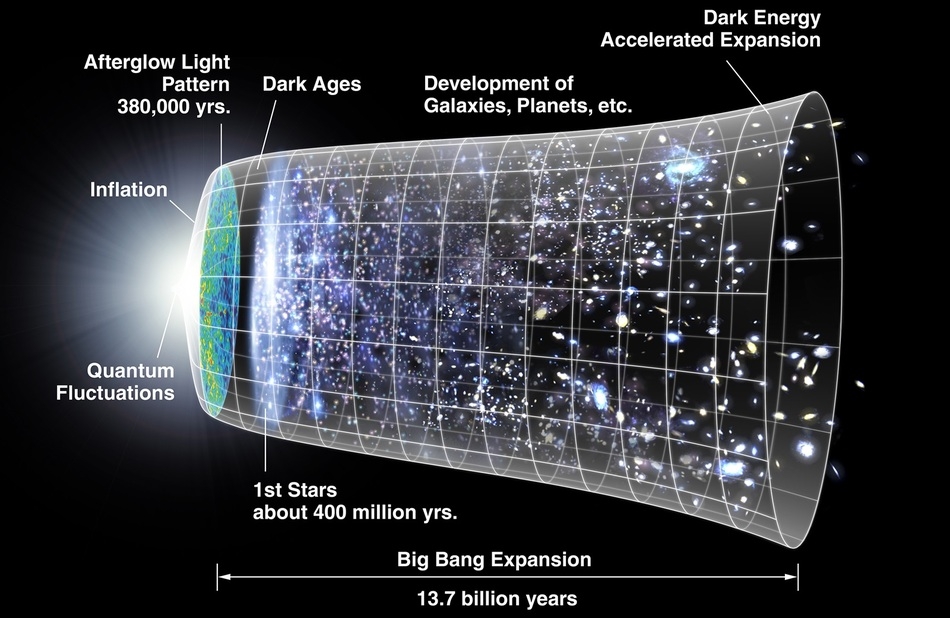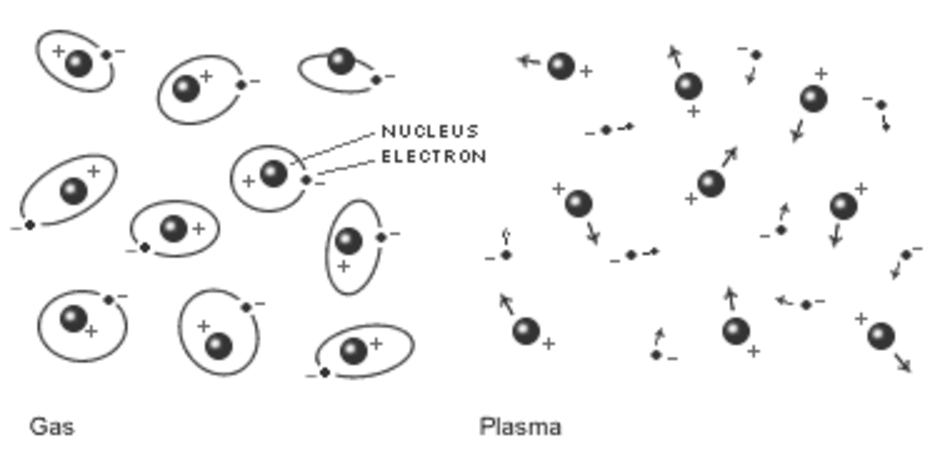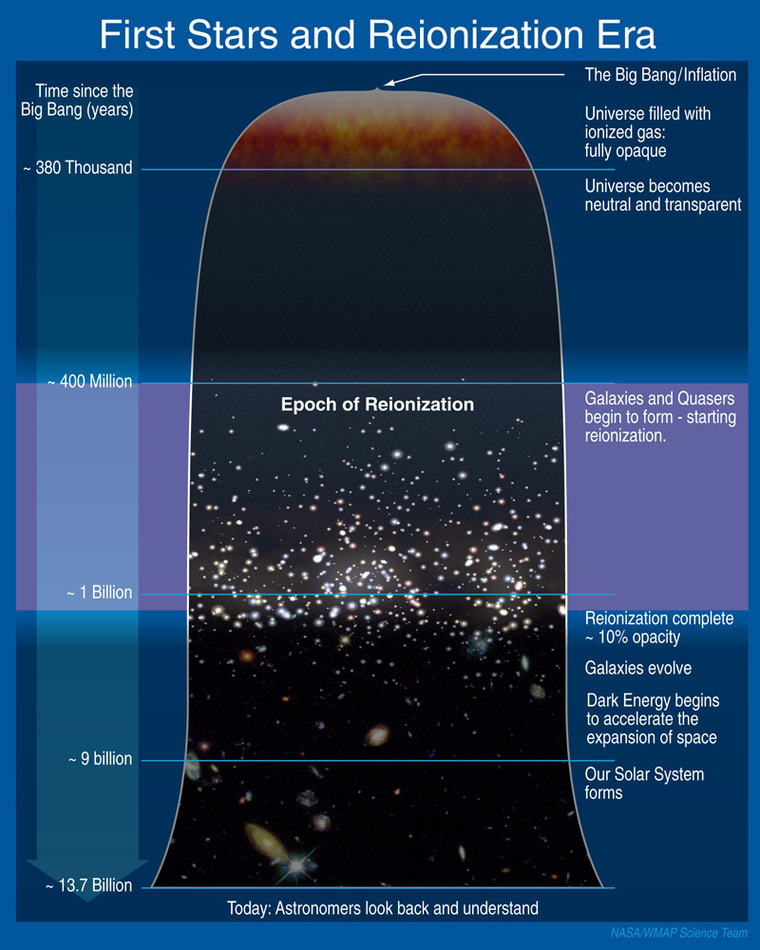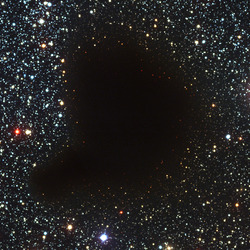
Contents
Introduction0 s - 15 min: Big Bang, heavy inflation and the formation of matter
15 min - 380 000 years: A particle soup, recombination and the Cosmic Microwave Background (CMB)
380 000 - 320 million years: The Dark Ages
320 million years: Reionization Era or The End of the Dark Ages
600 million years: The Milky Way begins to form
5 billion years: The Milky Way's galactic disk formed
9.3 billion years: Formation of our Solar System
10 billion years: First Life on Earth
11.7 billion years: Multicellular life evolves
13.3 billion years: Cambrian explosion
13.7 billion years: Chicxulub event
13.8 billion years: Homo sapiens
Introduction
This is the current state of the science regarding the birth and evolution of our universe. A few presumptions are not yet 100% secure and may still need to be amended in the future - and there are even some non-standard models that have a completely different approach to explaining the history of the universe. But the most convincing and most widely accepted hypothesis amongst scientists is the Big Bang Theory that will be described in this article. With this information at the back of your mind, let's start with the beginning, 13.8 billion years ago.
0 s - 15 min: Big Bang, heavy inflation and the formation of matter
Let's not try to answer what caused the Big Bang; this may be a question we will never be able to answer with certainty. Let's take the Big Bang as the starting point of our history.
Within the first single second of its existence the universe already went through various epochs. Starting with the Planck epoch the whole universe was compressed in an area smaller than your fingertip. At this point temperatures were so high that all four fundamental forces (gravitation, electromagnetism, weak nuclear interaction and strong nuclear interaction) were unified into one single fundamental force. The Planck epoch ended 10-43 seconds after the Big Bang. We won't go into too much detail, but after another few epochs (Grand unification epoch, Electroweak epoch, Quark epoch) the universe was 10-6 seconds young (one millionth of a second) and the fundamental forces had separated and taken their present form as we know them today.
Let's not forget one other important epoch that occurred during this very first period: the inflationary epoch. This was an epoch of heavy expansion of the young universe in which the volume of the universe is estimated to have increased by a factor of 1078. It ended 10-32 seconds after the Big Bang and the universe was now about the size of a typical galaxy. This doesn't mean that inflation of the universe itself stopped, just that the rate of expansion dramatically slowed down. In fact the universe has been expanding until today.
At 10-6 seconds after the Big Bang the heavy expansion had lowered temperatures sufficiently for quarks to form and be stable. Until 10-5 seconds the universe was composed of a "quark soup", an accumulation of the very basic building blocks of matter (quarks, leptons, antileptons, gluons and extreme high energy radiation). But after 10-5 seconds the universe had further expanded and cooled down enough to form stable protons and neutrons out of the quark soup.
At about 1 second after the Big Bang temperatures went down to about 1000 times the temperature of our Sun's core. You could now expect that the protons would fuse to heavier elements since we have all the ingredients for a nuclear fusion: protons and neutrons at high temperatures and high densities (like our Sun that in its core fuses hydrogen to helium at temperatures of more than 15 million K). But we still have to wait a few minutes for this to happen due to the enormous amount of high energy radiation in the early universe. As soon as the first step of the nuclear fusion chain to heavier elements occurs (fusion of a proton and a neutron to form deuterium) the high energy radiation will immediately blast apart the deuterium leaving us with just protons and neutrons again.
A few minutes after the Big Bang, temperatures and density dropped enough to pave the way for the era of nucleosynthesis. Parts of the hydrogen nuclei (protons) now can fuse to helium without being immediately destroyed. Finally - about 15 to 20 minutes after the Big Bang - when temperatures have cooled down enough to inhibit any further fusion we are left with a universe composed of roughly three quarters hydrogen and one quarter helium (this is by mass, counting the number of atoms it consists of about 92% hydrogen atoms and 8% helium atoms). There were also some trace amounts of other elements (mainly lithium and some radioactive isotopes), but until the first stars formed millions of years later the universe was composed of 99.999999% hydrogen and helium.
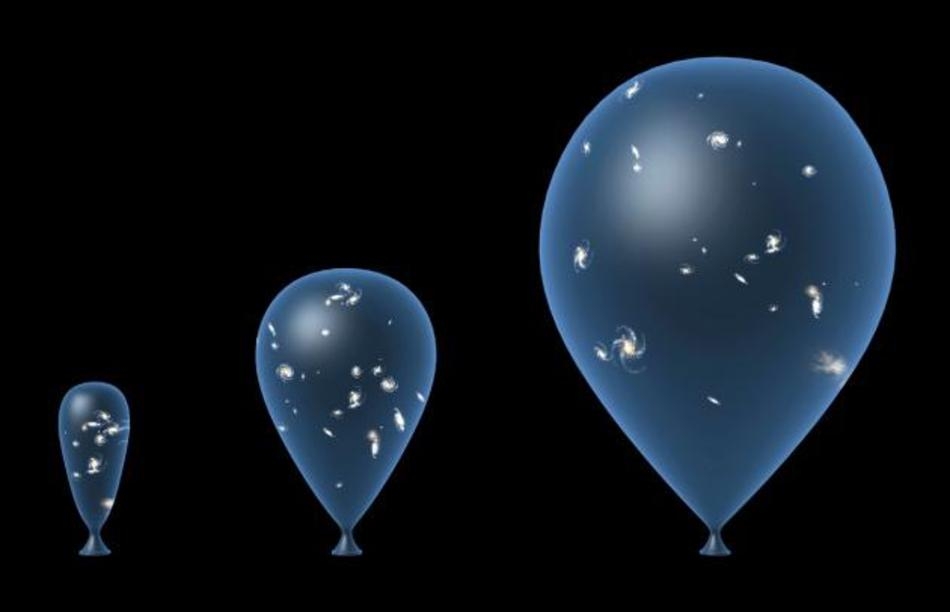 The expansion of the universe. Credit: Take 27 LTD/SPL.
The expansion of the universe. Credit: Take 27 LTD/SPL.
By the way: are you wondering why the universe cools down during its expansion? This cooling is different from what you might observe when a gas expands in a container on Earth; it's a consequence of the expansion of spacetime itself. As the universe expanded, the energy density decreased, leading to a cooling effect.
15 min - 380 000 years: A particle soup, recombination and the Cosmic Microwave Background (CMB)
While the first 15 minutes of the universe were really eventful, nothing really important happened - apart from further cooling and expanding - during the next hundreds of thousand years. Until 380 000 years after the Big Bang the universe is still just a "particle soup" composed of atomic nuclei and free floating electrons. This universe is still completely opaque since any radiation gets scattered in all directions by these free protons and electrons.
Around this time the universe got cool enough (about 3000 Kelvin) for the electrons and the atomic nuclei to combine to form neutral atoms. This process is called recombination. From that point in time the universe became transparent for a broad range of wavelengths. Since this radiation can now freely travel through space and is not scattered anymore, we are able to see the liberated radiation of this time (380 000 years after the Big Bang) even today! Due to the expansion of the universe from that point in time up to today, the radiation is stretched to a much longer wavelength - namely microwaves. Today we can observe microwave radiation in every direction of the sky, no matter where we look. This radiation is called the "Cosmic Microwave Background" (CMB) - it is the leftover of the Big Bang itself!
There is also a downside: this CMB forms a "wall" for any observation that we can conduct today. You can compare this to our Sun: we will never be able to image the core of the Sun from outside due to the opaqueness of the inner parts of the Sun. Why is the Sun opaque? Because the high temperatures inside the Sun cause a separation (or ionization) of the electrons from the atomic nuclei, again leaving us with an opaque soup of protons and electrons. Any light is scattered myriads of times in all different directions before it reaches the surface of the Sun after a voyage of more than 100 000 years. The same is the case with the Cosmic Microwave Background: we can see the CMB itself, but we will never be able to look behind this "wall". So, unfortunately we cannot see further back in time until 380 000 after Big Bang... and there is no hope that we might with better telescopes someday be able to see images of the Big Bang itself. Anyhow, being able to see the leftovers of the Big Bang means being able to look back for 99.997% of the time the universe has existed. And this is a marvellous achievement!
Because recombination did not occur instantaneously, in reality the CMB "wall" has a thickness of about 100 000 light years. The Cosmic Microwave Background is an image of the state of the universe 380 000 years after Big Bang with just very tiny fluctuations in temperature and density. These fluctuations were later amplified and led to the formation of the first stars and galaxies. The peak of the radiation has a wavelength that corresponds to a mean temperature of less than three degrees above absolute zero (2.725 K) with fluctuations of just a few hundred µK (less than 0.001 K).
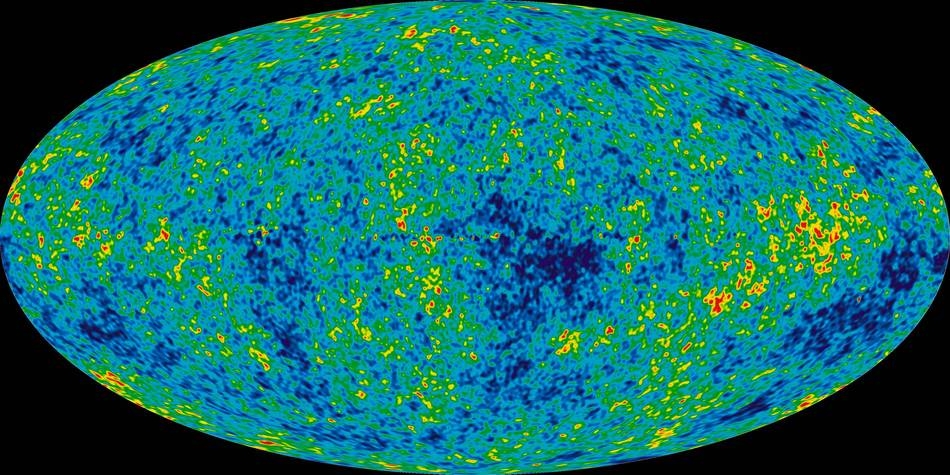 All-sky map of the temperature fluctuations from the Cosmic Microwave Background. Don't get confused by the different colours: the difference in temperatures is strongly magnified on this image, the temperature range is just ± 0.0002 K. Credit: NASA / WMAP Science Team
All-sky map of the temperature fluctuations from the Cosmic Microwave Background. Don't get confused by the different colours: the difference in temperatures is strongly magnified on this image, the temperature range is just ± 0.0002 K. Credit: NASA / WMAP Science Team2.725 K is the temperature that corresponds to the peak (strongest) radiation; in reality the radiation has many different wavelengths. The CMB behaves like a black body and any black body emits radiation in a broad range of wavelengths.
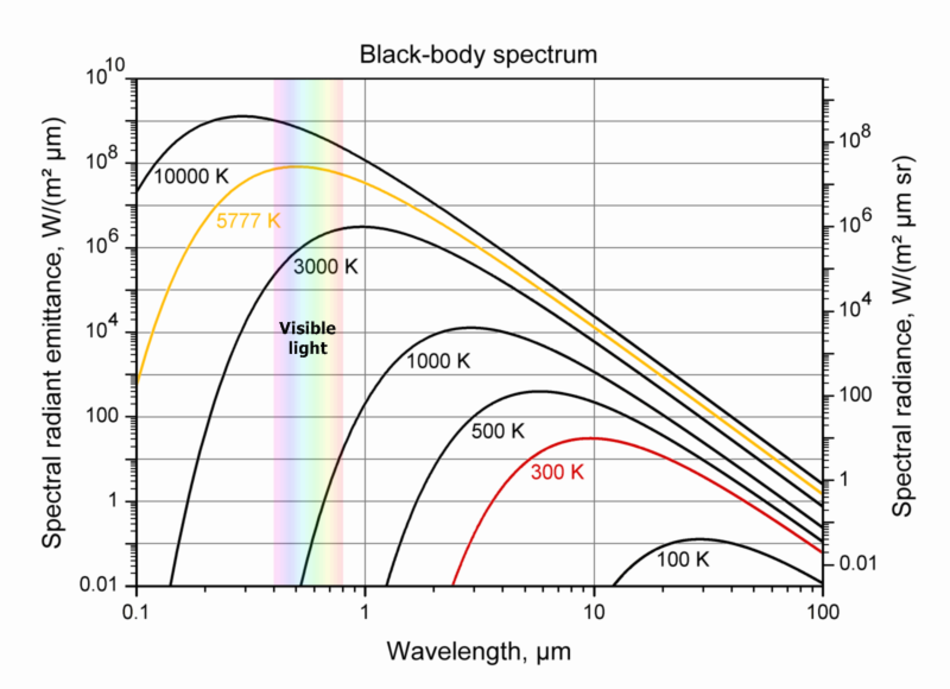 Any body with a certain temperature emits radiation with many different wavelengths. The peak wavelength for a body of e.g. 3000 K is around 1 µm. Our Sun is a black body too with a surface temperature of around 5777 K; that's why it emits most radiation in the ultraviolet and visible part of the spectrum. Source: Wikimedia Commons user Sch, adapted by Sun.org
Any body with a certain temperature emits radiation with many different wavelengths. The peak wavelength for a body of e.g. 3000 K is around 1 µm. Our Sun is a black body too with a surface temperature of around 5777 K; that's why it emits most radiation in the ultraviolet and visible part of the spectrum. Source: Wikimedia Commons user Sch, adapted by Sun.orgBy the way: don't get confused by the 3000 Kelvin we mentioned above (the temperature of the universe after 380 000 years) and the 2.725 Kelvin (the temperature of the CMB that we measure today). The difference comes from the expansion of the universe itself that has stretched the wavelength of the radiation to the current low value. This process will continue over the next billions of years since the universe continues to expand. The radiation from the CMB will have longer and longer wavelengths or - expressed the other way round - the measured temperatures will get lower and lower.
380 000 - 320 million years: The Dark Ages
The dark ages are the era when the universe was already transparent to many wavelengths, but no star had yet been formed. So there was no starlight emitted that we could observe today. The exact duration of the dark ages is not yet fully known. We have used 320 million years since, in 2022, the James Webb Space Telescope discovered a galaxy called JADES-GS-z13-0 whose redshift of 13.2 means it was already existing about 320 million years after the Big Bang. The image below still gives a date of 400 million years, but let's not be too harsh.
320 million years: Reionization Era or The End of the Dark Ages
Even though around the year 380 000 the universe had already become transparent to light with longer wavelengths like infrared radiation or radio waves, it was still not transparent to visible light. The universe was composed of neutral atoms that are opaque to visible light, similar to the dark cloud Barnard 68 which is mainly composed of neutral gas.
But the birth of the first stars in the universe changed this: they emitted a strong ultraviolet radiation that started kicking off the electrons of the neutral atoms. This process is called reionization and led to a universe that is finally transparent to visible light too. The process of reionization is beautifully illustrated in the following video:
Video credit: Nick Gnedin - https://home.fnal.gov/~gnedin/
These young stars finally ended the epoch called the "Dark Ages" leading to a universe more or less as we know it today. If you are wondering why most of the gas (mainly hydrogen) is neutral again today and why we still see distant galaxies, then you have been paying close attention! As the universe continued to evolve and expand, the density of these ionizing sources decreased, and the space between galaxies increased. The intense ionizing radiation became less prevalent, allowing the universe to transition back to a state where much of the hydrogen became neutral once again. After many billions of years of expansion, almost the entire universe is now "empty" or more precisely: the density of the gas is very low (especially outside the galaxies). Therefore, we can once again see long distances through the universe. Our article on the interstellar medium gives you a good overview.
600 million years: The first stars of the Milky Way form
The oldest stars of the Milky Way formed at about this time. The star HE 1523-0901 was discovered in the halo of the Milky Way showing that the Milky Way already started accumulating matter at a very early stage of the universe.
5 billion years: The Milky Way's galactic disk formed
Almost 5 billion years after the formation of the galactic halo, the Milky Way developed its disc composed of several spiral arms. We know this since the oldest stars that we can observe in the disc of the Milky Way have an age of 8.8 billion years, hence they were formed about 5 billion years after the Big Bang.
9.3 billion years: Formation of our Solar System
Our Sun and the entire Solar System were formed from a collapsing cloud of gas and dust.
10 billion years: First Life on Earth
The first few hundred million years on Earth were tough. Huge asteroids and comets crashed onto Earth; even a planet of the size of Mars may have crashed into the young Earth, thereby forming our moon (Giant Impact Hypothesis). Earth's surface was completely molten; no life form as we know it could develop under these circumstances. But after about 500 - 600 million years things calmed down and the Earth could offer moderate temperatures and water. Surprise: not much later the first life on Earth evolved. Quite a fast victory of nature! If you think of the 10 billion planets just in the habitable zone of just our Milky Way... who cannot wonder how much life there might be out in the universe. Who knows, maybe one of the next generations of telescopes might already be able to trace molecules in other planets’ atmospheres that could only have been produced by a biological process (such as e.g. O2 in high concentrations)!
11.7 billion years: Multicellular life evolves
Multicellular life has now evolved on Earth. Why this took so long in the Earth's history (after all, there was only single-celled life for around three billion years), whether we were very lucky or whether we were "late" on Earth, has not yet been clarified with certainty. The exact number of times multicellularity evolved independently on Earth is still a subject of scientific investigation and debate. While multicellularity has evolved multiple times, it's challenging to pinpoint the precise number of independent events. There is evidence to suggest that multicellularity has arisen independently in different lineages. For example, animals, plants, fungi, and some protists (e.g., algae) all represent distinct branches of the tree of life that have independently evolved multicellularity. Within these groups, there are numerous lineages that have independently transitioned from single-celled to multicellular forms.
13.3 billion years: Cambrian explosion
About 542 million years ago almost all major animal phyla developed in a relatively short period of less than 20 million years.
13.7 billion years: Chicxulub event
About 65 million years ago a giant meteorite impact caused the extinction of the dinosaurs, clearing the way for primates to evolve to be bigger than it had been possible under the reign of the superior dinosaurs. Some rat-like animal later evolved to a species called...
13.8 billion years: Homo sapiens
Finally, here we are. Let us hope that Homo sapiens is intelligent enough to not destroy itself and is able to preserve our planet with its flora and fauna that share Earth with us. It was just way too much work from the Big Bang to today to risk wasting all that effort.
